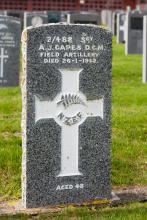He won the Distinguished Conduct Medal in the late stages of the Battle of Passchendaele October 1917
He was killed near Paremata, Porirua setting up defense for the main truck railway in January 1942.
2/488 Sergeant Arthur (Jack) John Gapes, 3rd Battery, NZ Field Artillery 1914-1918
Born and raised in Northland, Wellington he was 'almost' 20 when he volunteer in 1914 as Driver Gapes he served throughout the Gallipoli Campaign.
Promoted to Corporal Gapes in 1916 he was promoted to T/Sergeant 3rd Battery, 1st Brigade prior to Messines.
In October 1917 Battle of Passchendaele the 3rd Battery remained to support the Canadian Corps after they relieved the battered NZ Division. The Canadian Corps launched two assaults on the 26th August and the 30th August 1917 it was in this assault that Sergeant Gapes won his Distinguished Service Medal.
"as one of a forward observation party (FOP) while going forward they were caught in a barrage one man being killed and the officer and remaining man badly wounded. Although badly wounded in two places and slightly in others he crawled through the barrage and succeeded in getting the wounded away on stretchers,. He then returned to his post and endeavored to send a report through.”
The man killed was 13/2887 Gunner Ellis Alexander Parr, Military Medal (MM) Gunner Parr won the MM in similar circumstances in the June Battle of Messines.
Dangerously ill with wounds to his legs and face Sergeant Gapes was evacuated to the 1st Australian General Hospital where foreign bodies were removed from his knee. Sgt Gapes was evacuated to London's 2nd General Hospital and finally on 23rd November 1917 to the 1st NZ General Hospital, Brockenhurst.
Assessed as no long fit for active service Sergeant Gapes was shipped back to New Zealand and discharged. Jack returned to his mother's home in Northland.
Jack married in 1924 Nancy Bickerton, Jack was the manager of the Northland Quarry and the couple remained with Jack's mother and raised three children.
In WW2 2/18/288 Corporal Gapes, a territorial, was called up to serve in B Company, 3rd Battalion, Wellington Regiment. The threat of Japanese attacks resulted in preparation of defenses around vital points. On 26th January 1942 was part of wiring detail at the Paremata railway bridge. There was a strong northerly blowing at 10:10 am when the Wellington to Napier Express reached Paremata. The driver sounded a warning whistle prior to rounding a curve and approaching the rail bridge. The driver noted three men on the tracks applied emergency brakes but one man was struck by the train.
The inquest noted that Corporal Gapes was in the center of the tracks with two young Privates while the young Privates saw the train Corporal Gapes had his back to the train and was slow to react even though one of the Privates tried to grab him when jumping clear. It is possible that Corporal Gapes was slightly hard of hearing after years of serving with the artillery and also was not as agile as the young men given the wounds he received in October 1917.
Corporal Gapes was taken to Wellington Hospital but died of his injuries.
Arthur (Jack) John Gapes was given a military funeral and buried in the Soldiers Section, Karori Cemetery.
Jack left Nancy and three young children, the youngest only two.
Nancy remained in the family home until the late 1980's when she moved to the Waikato district to be close to family.
Nancy Gapes died in Hamilton in 2002 and is buried there.
Source: Allan Dodson, Porirua War Stories


